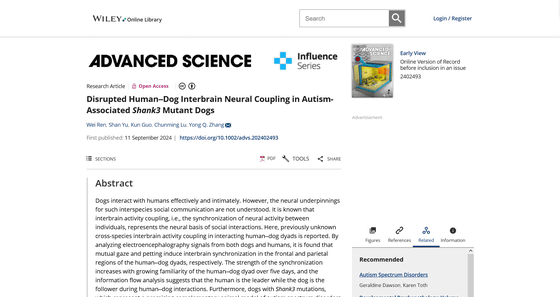It turns out that when dogs and humans look at each other, their brain activity synchronizes

Dogs are said to be the oldest animals to have lived with humans, and have been loved as pets since ancient times. A research team from the Institute of Genetics and Developmental Biology, Chinese Academy of Sciences, measured the brain waves of humans and dogs and reported that they found that when humans and dogs make eye contact, their brain activity synchronizes.
Disrupted Human–Dog Interbrain Neural Coupling in Autism‐Associated Shank3 Mutant Dogs - Ren - Advanced Science - Wiley Online Library
https://onlinelibrary.wiley.com/doi/10.1002/advs.202402493

Dogs' Brains Sync With Ours When We Gaze Into Their Eyes, Study Finds : ScienceAlert
https://www.sciencealert.com/dogs-brains-sync-with-ours-when-we-gaze-into-their-eyes-study-finds
The research team prepared 10 pairs of beagles and humans and had them live together for five days. During this time, they measured the brain waves of the dogs and humans and investigated the effects of eye contact and touching each other.
Next, the effects of the actions of 'eye contact' and 'touching each other' were investigated separately. In addition, a similar experiment was conducted using 13 dogs with a mutation in the SHANK3 gene, which is believed to be the causative gene for autism spectrum disorder, and the differences were compared with dogs without the mutation. In addition, an experiment was conducted in which a single dose of LSD was administered to dogs with a mutation in the SHANKS3 gene to examine its effects.

As a result of the experiment, the synchronization of brain activity was observed when dogs and humans made eye contact or touched each other. The research team reports that synchronization was observed mainly in the frontal lobe area when the dogs made eye contact, and in the parietal lobe area when the dogs touched each other. The direction of this synchronization was 'from human to dog,' and it was found that the synchronization tended to become stronger after five days of living together.
In addition, dogs with the SHANK3 gene mutation were significantly less able to synchronize with human brain activity, and also showed reduced attention spans. However, a single dose of LSD improved both the synchronization and attention span problems.

The research team suggested that a neurological bond exists between humans and dogs, and that this bond may be impaired in conditions such as autism spectrum disorder. It also shows that LSD may improve dog-human interaction disorders. However, the research team also pointed out limitations, including the need to investigate human-dog interactions in more natural settings, and limitations in interpreting EEG data.
The research team said, 'This is the first time that we have reported synchronization of brain activity across species, and this will be an important finding in understanding the neural mechanisms of social interactions between humans and dogs. ' They also argued that synchronization of brain activity may be a biomarker for autism spectrum disorder.
Related Posts:







